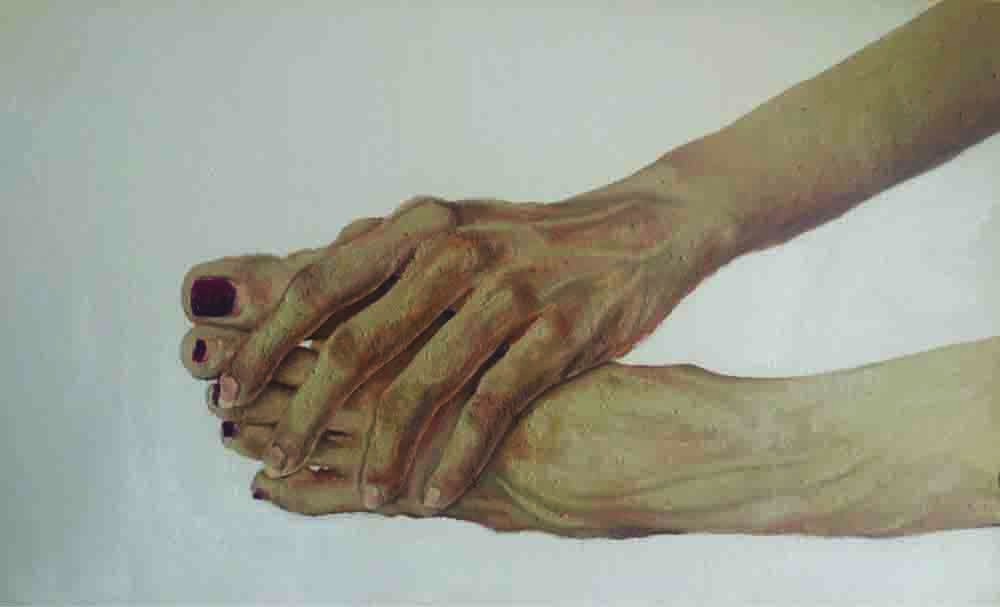
A group show at the Taseer Art Gallery Lahore promises to be a lot more than being just about queer aesthetics

It was around 1990 that Channel 4 showed a series of short films based on the translations of Gabriel Garcia Marquez’s texts called Dangerous Loves. These episodes explored the imperceptible difference between pain and pleasure, generally associated with amour: couples in extramarital liaisons caught due to minor negligence; growing boys in relationships that turned fatal with a small stroke of fate; love affairs that brought unexpected demise at the end. The director conveyed the Colombian author’s views on the bondage between sex and suffering.
This is not unusual in a society that only has vulgar expressions for love making. Generally too, sensuous adventures are equated with hunting one’s prey etc. Both animals and human beings prolong their species through mating but what distinguishes them is the existence of love. Human fall in -- and also out of -- love and maintain the feeling of love for their companions.
Yet within that human love, one can detect a sense of misery. As seen in the recent exhibition ‘Ugly Pretty’ being held from September 14-28, 2017 at Taseer Art Gallery Lahore. The curator, Aziz Suhail, has invited a number of artists, aspiring, well-established and recent graduates, to be a part of the show which as he said in the introductory words at the opening is about queer aesthetics. The exhibition includes works by Abdullah Qureshi, Amna Rahman, Inaam Zafar, Irfan Hasan and Sara Khan -- mostly paintings, either in water or oil-based medium.
Including some convincing imagery and canvases by Irfan Hasan and Amna Rahman, the show communicates many fact or fabrications about art and art world. For instance, how is an art work created by the maker, read by the curator and understood by the viewer. Then, how a personal practice and preference can be a source of inspiration or tool of art-making for an individual; because all participants, in terms of their sexual orientation, do not fall into a single category.
When it comes to art, one realises the relation between sexes usually contributes towards defining, deciphering, as well as confusing an art work. For example, the meticulous portraits by Irfan Hasan of boys from Northern Areas of the country (Hunza) or women painted by Amna Rahman who could have been from anywhere suggest a larger narrative -- where being an ordinary person, without an obvious sexual agenda, is enough. Women depicted in intimate attires or men with beards do not limit us to one set of reading because our identities are multi-layered, composite and complex. A man sporting a conventional beard can also be mad about Madonna’s songs. Or a girl touching her body or skimpily dressed could be interested in her own physique instead of other beings of her gender.
One realises these artists are dealing with wider (or narrow) issues of our existence, but a curator’s decision to include works of separate artists in ‘queer’ aesthetics is crucial. Because it discloses the pattern of power when it comes to a maker and a curator, critic or interpreter. Artists like Hasan, Zafar and Khan are not engaged with the narrative of homosexuality because, in their works, one finds references that are varied and open to interpretation. For instance, in Inaam Zafar’s ‘Imprint Series’ parts of body are presented without any identity but with love bites which could also be read as marks of violence on flesh. The red patches may refer to physical passion as well as to victims of terror.
The other artist, Sara Khan who has sent her work from Canada is showing a group of faces -- almost mask-like. Here one detects the craze of taking one’ selfies or various states of individuals who are not necessarily deranged but appear odd almost alien when displaced from their context. With a simple title, Her, Him, Them, She, Me, Us, We, and He, these single faces due to their constructions invoke the aspect of grotesque that all of us hide inside us.
The curatorial note reads "There is an emphasis on an erotic aesthetics", but it seems this ‘erotic aesthetics’ only resides in the imagination of the curator or is reflected in the work of one artist; because to be naked is not being erotic, or "eroticism cannot be reduced to pure animal sexuality" (Paz).
Thus, the exhibition is a pretty good example of misinterpretation, since it is almost impossible to find any erotic sensibility in the masks/faces made by Sara Khan, portraits of Pathan boys painted by Irfan Hasan, clasped hands, a hand holding foot, or a girl partially dressed yet in normal posture, all created by Amna Rahman.
Even though in a few works by Qureshi, one could trace the torso of male bodies mostly daubed in shades of human flesh; and positions and selections of these figures do indicate a certain leaning, but even in these works one feels the reluctance at a higher level. One may suspect the link with male sexuality, but otherwise the pieces can be read as a beginner’s exercises in human anatomy. These works, and through these the artist’s character, remind of David Hockney’s paintings, especially his series of men taking showers or lying with their bare bottoms exposed near the pool. Setting eyes on Hockney’s canvases, one discovers the sexual taste of the British artist and not the other way around.